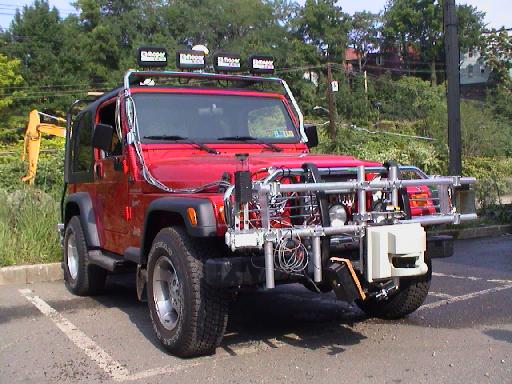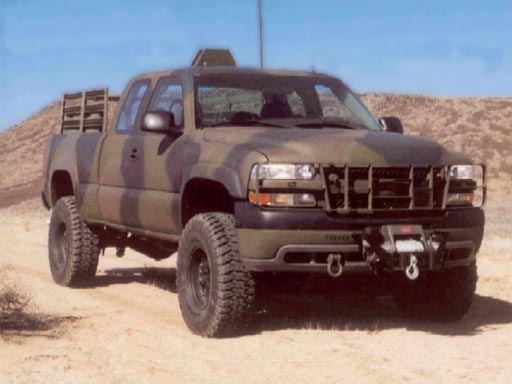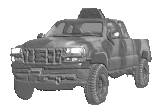|
|
For
participants only. Not for public distribution.
|
Note #2
John Nagle |
Introduction
I'm writing this as someone who doesn't do much off-roading, although I do own a 4x4 Ford Bronco. (My main off-road vehicle is a horse.) We're going to need expertise from someone who spends time driving in the dirt. We'll need more access to engineering data than the typical car buff, so we're going to have to develop some contacts in auto and parts companies. We'll need to do, or outsource, quite a bit of hard work. But the job is comparable in scope to customizing a truck for racing, a task routinely accomplished by small teams.
Completing the race is the hard part
This race is 300 miles in the desert, probably spread over two days with an overnight stop. A likely outcome of this event is that nobody completes the race.
No autonomous ground vehicle has ever gone this far in a hostile environment without occasional human assistance.
It's tempting to look at pictures of 140 MPH Baja race trucks, and visualize something similar, but they're on a known course and have experienced human drivers. Off-road performance of the CMU NavLab vehicles, after a decade of work, was around 3-10MPH. (On-road speeds on good roads were comparable to human performance, although the CMU on-road driving systems make assumptions not valid for a dirt road in the desert.) I'm thus thinking in terms of what may seem conservative speed goals for a race - maximums of 10-20MPH off-road, 25-40MPH on-road
Mechanical reliability, not speed, is the key here. Looking at off-road desert race results, about half the vehicles finish 150-300 miles races.
Competition / existing vehicles
As of right now, we know of no other entrants.For comparison, here's the latest CMU NavLab vehicle.
 |
|
This is the 11th NavLab vehicle. Others have included vans, passenger cars, and a HUMMV.
Jeep Wranglers are notorious for rolling over, so they're not a good choice for our project unless we go in for modifications to widen the stance. And if that thing hits so much as a bush, the sensor suite will be damaged.
Here's a rugged, near off-the-shelf truck. The GMC COMBATT is a modified General Motors pickup truck. GM is offering this to the Department of Defense as a low-cost military vehicle, an alternative to the more expensive HUMMV.
 |
|
The COMBATT is basically a current model GMC Sierra pickup with off-road features. It indicates what options and add-ons GM Defense Division Engineering thinks an off-road pickup truck should have.
It's not normally possible to buy this directly, but we might talk to GM for support, and at least find out what components can be used.
It's significant that the EATON VORAD system has been interfaced to this truck. That engineering problem has been solved.
Interfacing with the vehicle
You can't, as yet, buy a drive-by-wire light truck. There are large drive-by-wire vehicles, but the technology isn't in light vehicles yet.
Automotive equipment manufacturers are developing full drive-by-wire control systems, and there's even a format war between the FlexRay and TTA network standards for steer-by-wire and brake-by-wire. But they're not in products yet.
The big four drive-by-wire functions are shift, steer, brake, and throttle.
Shift-by-wire
Heavy trucks are starting to network their onboard electronics using the SAE J1939 control-area network standard, which is a ruggedized LAN of modest speed (250Kb/s). Many heavy-truck components that talk SAE J1939 are available, including the Eaton VORAD anti-collision radar system. Allison transmissions for medium and heavy trucks talk J1939, and Allison transmissions are available on pickup trucks, but it's not yet clear if the light truck transmissions can be commanded over the net. The smallest listed transmission with J1939 is for a motor home.
There is a third-party shift-by-wire system for Allison 1000 transmissions, which are available in GM pickups. Looks good.
We need to be able to back up. Not very fast, just enough to get turned around. Otherwise, an unexpected obstacle like a tumbleweed can stop us completely.
Steer-by-wire
Steering is the tough one. The Trimble AgGPS Autopilot, which appears to be one of the very few computer-controlled steering units in commercial production, interfaces to tractors at the power steering unit. This may work only for tractors that steer with a hydraulic cylinder, though. We need to find out more about this. (Update: this system assumes that tractor steering works with a hydraulic cylinder, which isn't the case on a light truck. So that's not a useful actuator.)
The Delphi E-Steer system looks promising. This is an electric steering power-assist system, a direct replacement for existing hydraulic power-assist systems. It's not full steer-by-wire; the standard mechanical connection with the steering wheel is maintained. E-Steer consists of an electric motor, a torque sensor, and a control unit. Over a million units have been produced, but for small cars in Europe. GM is buying into the technology and Delphi has built a new plant in Michigan to make more of them, and larger versions.
A college team at University of Wisconsin–Madison has used a Delphi E-Steer unit in a GMC Suburban converted to electric drive. So units exist that work on larger vehicles. (Update: the college team actually used a different unit which is just a standard power steering unit with its own electric-powered hydraulic pump. That's not useful. E-Steer itself looks useful, but the unit for larger vehicle isn't in volume production yet.)
Omnitech sells teleoperation kits for heavy equipment. Their specs match the requirements for the Common Robotic Kit mentioned in Note 1. Their approach consists of standardized drive units which pull and push control cables, with the cables attached to the appropriate human-oriented control devices. They also sell useful units like TV pan and tilt mounts, inertial, and GPS units. They even offer an autonomous HUMMV capable of driving round and round a preset course. The mechanical approach is a bit brutal; they just attach push-pull control cables to everything with an actuator box on the other end of each.
Brake-by-wire
Brake-by-wire is complicated, because braking today is tied in with stability and anti-lock braking systems. We're going to need information back from those systems to get "road feel", at least to the point that we can tell if the braking system is actively dealing with a control problem. Absolute minimum returned info is "braking/stability system is active", an indication to slow down and straighten the steering.
Throttle-by-wire
(to be supplied) Can we do this through the "cruise control" interface?
Vehicle auxiliary systems
On a heavy truck, we could get access to most of these just by plugging into the J1939 bus. So we may be able to find heavy-truck components that will give us this connectivity.
We're going to be driving this vehicle off-road a lot during testing. So the vehicle needs to protect itself.
Windshield washer
Control of the humble windshield washer and wiper is essential to keeping the cameras functioning in the dirt. We may well need an auxiliary windshield washer fluid tank. Current thinking is to put the main cameras behind the windshield. We may have a second camera stereo pair on the front bumper, aimed downward, to handle blind hill crests, and that unit will need a washing system.
It's worth considering a high-pressure windshield washer system able to blast mud and dirt off. We need to talk to off-road racers about this.
Engine start/stop
We're required to have engine emergency stop. We will also need computer-controlled engine starting, in case the engine stalls. We can probably buy that.
Temperatures
It would be useful to have visibility into engine and transmission temperature, so we can slow down if the engine is overheating. It's a desert race, after all.. We will, of course, get every heavy-duty cooling option available. We may be able to leave engine self-protection to the stock engine control unit. Most of this information can be obtained through the usual J1962 diagnostic port.
Fire extinguishing
Off-road vehicles normally carry fire extinguishers, but ours must be automatic. Such things are available for boats. They're basically an ordinary extinguisher canister with a fusible-link sprinkler head. They provide an electrical indication of extinguisher discharge, which we must wire into the emergency-stop chain. The activation temperatures for marine extinguishers are low for under-hood location, though; we may need a higher-temperature sprinkler head.
Outside lights
No reason to get complicated here; they're probably on all the time.
Displays
A LED sign in the rear window, displaying messages for the benefit of the chase vehicle, might be useful, for those "what is it doing" situations.
Emergency stop system
We're required to have emergency stop buttons outside the vehicle and a radio-controlled emergency stop system. Simple industrial-strength radio control systems are available. The one listed looks like a garage door opener, but transmitter and receiver have industrial temperature ranges and specs. It has 1200' range, which may be a bit low but is probably adequate. It signals an emergency stop on loss of signal, as required, and is designed to be used in safety-critical applications.
We probably want both "freeze" and "kill" functions, as is common in industrial robotics. ("Freeze" gets you a controlled stop, "Kill" drops all power immediately.) We're required to have remote restart.
What to do on an emergency stop signal? The vehicle has to be stopped and then stay put, even on hills. Just cutting the engine is insufficient. A separate emergency-stop brake actuator will be needed. That actuator has to keep heavy pressure on the brake system indefinitely, enough to park without engine power. Something like a ball screw acting through a spring on the brake pedal would work. When triggered, a motor drives the screw to its limit stop. This may or may not be our primary brake actuator.
"Freeze" should tell the software to do a stop, then, after a delay of several seconds, do a "kill". The idea is that it's always OK to punch "Freeze", but "Kill" may cause problems if the vehicle is in a difficult situation.
Should loss of communications do a "freeze" or a "kill"? Probably "Freeze". The rules permit a restart after a loss of signal, and we may well have some just because the chase vehicle falls behind.
Mode control
The vehicle needs to be driveable safely in "full manual" and "auto" mode. In "full manual" mode, it should still be possible to let all the computer systems run, looking at what's going on and reading data from the vehicle systems, but unable to command the vehicle.
The ability, within the vehicle system, to manually set a maximum speed, enforced by the emergency stop system, is needed for testing.
Sensors
Sensors will be addressed in a separate note. But for vehicle planning purposes, assume cameras behind the windshield, a camera pair in the front bumper, EATON VORAD radar antennas including side-obstacle detection, truck-type back-up obstacle sensors (probably radar, not ultrasonic, for dirt resistance), and rangefinding devices (probably the same units as the back-up obstacle sensors) pointed downward just ahead of the front wheels to detect sharp drop-offs.
Suspension
(to be supplied) Will probably include lift kit, but let's not overdo this. The lift on that "COMBATT" truck above is probably about right. We may want to consider some of the available options for extra suspension travel.
Vehicle protection
The usual skid plates, brush guards, roll cage, etc. It's common in racing trucks to use extra heavy skid plates to lower the vehicle center of gravity, and we may want to do that to reduce the risk of rollover. Bear in mind that we'll be driving this thing on autopilot with people inside during testing. We'll need the usual driver protections.
Tow hooks
We'll need usable tow hooks, front and back. Sooner or later, we'll probably have to haul the vehicle out of a ditch. Attachment points for a tow bridle, so it can be towed with a trailer hitch, are also indicated. If it breaks down in the field, we'll need to bring it home.
Fuel tanks
We need to run the whole race without refueling. Assuming 400 miles of fuel at 8MPG, (is that a conservative enough estimate?) we need about 50 gallons of Diesel fuel tankage, for which auxiliary tanks are required, but available. Race-type fuel cells should be used to reduce fire risk.
Electrical power
We'll need to work up an electrical power budget, to see if we need power beyond the normal vehicle capacity. It's probably going to be close. Dual batteries and the biggest stock alternator available, definitely.
Interior
Mostly standard. Two seats. Maybe 5-point racing harnesses, in case of a rollover. Various controls, to be defined, in the center console. There will probably be times when someone is in the right seat with a laptop.
Project standards
Safety is a major concern, more during testing than during the race itself. At one time or another, we'll all probably try riding in the vehicle on autopilot.
All automotive work must be done to the standards of a good truck customizing shop. We may outsource work to a such a shop.
The vehicle must still be street-legal for manual driving. Otherwise, moving it around requires a trailer.
All components of the vehicle system must be automotive, industrial, heavy truck, or military quality. This includes electrical and electronic components, and, especially, connectors.
The "vehicle system" should interface to the "control system" only through a narrow interface, preferably a J1939 network connection. For planning purposes, assume a "computer box" behind the seats plugged into the vehicle network. The sensing systems (cameras, etc.) will not be on the vehicle network, except for standard automotive units like the EATON VORAD radar system.
Welding, not duct tape.
Conclusion
This note describes quite a bit of work. But it's all possible. Nothing here pushes the state of the art in automotive technology.
